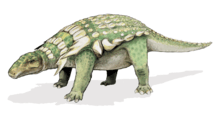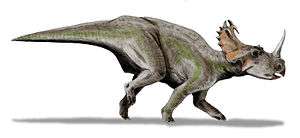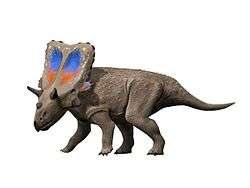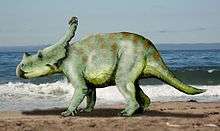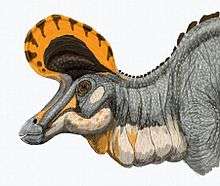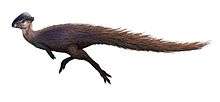Dinosaur Park Formation
| Dinosaur Park Formation Stratigraphic range: Late Cretaceous, 76.6–74.8 Ma | |
|---|---|
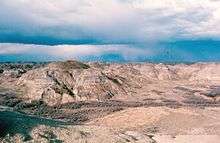 Dinosaur Park Formation exposed along the Red Deer River in Dinosaur Provincial Park, southeastern Alberta, Canada. | |
| Type | Geological formation |
| Unit of | Belly River Group |
| Underlies | Bearpaw Formation |
| Overlies | Oldman Formation |
| Lithology | |
| Primary |
Sandstone (lower) Mudstone and siltstone (upper) |
| Other | Bentonite and coal |
| Location | |
| Region |
|
| Country |
|
| Type section | |
| Named for | Dinosaur Provincial Park |
| Named by | Eberth, D.A. and Hamblin, A.P., 1993.[2][3] |
The Dinosaur Park Formation is the uppermost member of the Belly River Group (also known as the Judith River Group), a major geologic unit in southern Alberta. It was laid down during the Campanian stage of the Late Cretaceous epoch between 76.6 and 74.8 million years ago.[1][4] It was deposited in alluvial and coastal plain environments, and it is bounded by the nonmarine Oldman Formation below it and the marine Bearpaw Formation above it.[4]
The Dinosaur Park Formation contains dense concentrations of dinosaur skeletons, both articulated and disarticulated, which are often found with preserved remains of soft tissues. Remains of other animals such as fish, turtles, and crocodilians, as well as plant remains, are also abundant.[5] The formation has been named after Dinosaur Provincial Park, a UNESCO World Heritage Site where the formation is well exposed in the badlands that flank the Red Deer River.[3]
Geological setting

The Dinosaur Park Formation is composed of sediments that were derived from the erosion of the mountains to the west. It was deposited on an alluvial to coastal plain by river systems that flowed eastward and southeastward to the Bearpaw Sea, a large inland sea that was part of the Western Interior Seaway. That sea gradually inundated the adjacent coastal plain, depositing the marine shales of the Bearpaw Formation on top of the Dinosaur Park Formation.[4]
The Dinosaur Park Formation is about 70 metres (230 ft) thick at Dinosaur Park. The lower portion of the formation was laid down in fluvial channel environments and consists primarily of fine- to medium-grained, crossbedded sandstones. The upper portion, which was deposited in overbank and floodplain environments, consists primarily of massive to laminated, organic-rich mudstones with abundant root traces, and thin beds of bentonite. The Lethbridge Coal Zone, which consists of several seams of low-rank coal interbedded with mudstones and siltstones, marks the top of the formation.[4]
The sediments of the Dinosaur Park Formation are similar to those of the underlying Oldman Formation and they were originally included in that formation. The two formations are separated by a regional disconformity, however, and are distinguished by petrographic and sedimentologic differences. In addition, articulated skeletal remains and bonebeds are rare in the Oldman Formation but abundant in the Dinosaur Park Formation.[3][4]
Biostratigraphy
The Dinosaur Park Formation can be divided into at least two distinct faunas. The lower part of the formation is characterized by the abundance of Corythosaurus and Centrosaurus. This group of species is replaced higher in the formation by a different ornithischian fauna characterized by the presence of Lambeosaurus and Styracosaurus. The appearance of several new, rare species of ornithischian at the very top of the formation may indicate that a third distinct fauna had replaced the second during the transition into younger, non-Dinosaur Park sediments, at the same time an inland sea transgresses onto land, but there are fewer remains here. An unnamed pachyrhinosaur, Vagaceratops irvinensis, and Lambeosaurus magnicristatus may be more common in this third fauna.[6][7]
The timeline below follows a synthesis presented by Arbour et al. 2009[1] with additional information from Evans et al. 2009 and Penkalski, 2013.[8] Megaherbivore Assemblage Zones (MAZ) follow data presented by Mallon et al., 2012.[9]

Amphibians
Remains of the following amphibians have been found in the formation:[10]
Albanerpetontidae (extinct, salamander-like amphibians)
- Habrosaurus
- Lisserpeton
- Opisthotriton
- Scapherpeton
- unnamed caudatan
- 2 indeterminate caudatans
Salienta (frogs)
- 2 unnamed salientans
Dinosaurs
Remains of the following dinosaurs have been found in the formation:[1][11]
Ornithischians
Remains of the following Onrithischians have been found in the formation:[12]
Ankylosaurs
| Ankylosaurs reported from the Dinosaur Park Formation | ||||||
|---|---|---|---|---|---|---|
| Genus | Species | Location | Stratigraphic position | Material | Notes | Images |
|
D. acutosquameus |
Lower, 76.5Ma ago[1] |
| ||||
|
E. rugosidens |
Lower, 76.5-75.9Ma ago[1] |
|||||
|
E. tutus |
Lower to Middle, ~76.4-75.6Ma[8] |
An ankylosaurine ankylosaurid. | ||||
|
P. mirus |
Middle, 75.6Ma ago[1] |
"Partial skeleton with complete skull, osteoderms, additional isolated teeth, postcranial elements, osteoderms."[13] |
A nodosaurine nodosaurid. | |||
|
S. cutleri |
Lower, 76.5Ma ago or more[8] |
An ankylosaurine ankylosaurid briefly thought to be synonymous with Euoplocephalus. It possibly came from the upper layers of the underlying Oldman Formation.[8] | ||||
Ceratopsians
An unnamed Pachyrhinosaurus-like taxon has been recovered from the formation.
| Ceratopsians reported from the Dinosaur Park Formation | ||||||
|---|---|---|---|---|---|---|
| Genus | Species | Location | Stratigraphic position | Material | Notes | Images |
|
C. apertus |
Middle, 76.2-75.5Ma ago[1] |
"[Fifteen] skulls, several skeletons, all adult; abundant bone-bed material with rare juveniles and subadults."[14] C. nasicornis may be a synonym. |
| |||
|
C. belli |
Middle, 76-75.5Ma ago[1] |
"[Twelve] skulls, several skeletons."[14] |
A chasmosaurine ceratopsid. | |||
|
C. russelli |
Lower, 76.5-76Ma ago[1] |
"[Six] complete or partial skulls."[15] | ||||
|
M. gemini[16] |
Lower, ~77Ma ago[16] |
"one apomorphic squamosal"[16] |
A chasmosaurine ceratopsid. | |||
|
M. lowei |
A centorsaurine ceratopsid. | |||||
|
P. aquilonius[17] |
Uppermost, 74.8 MA[17] |
two frill fragments[17] |
A chasmosaurine ceratopsid. | |||
|
S. sternbergorum[18] |
Lower, 76.5Ma[18] |
"partial parietal bone, partial dentary, unidentifiable limb fragments, partial skull, and partial right squamosal."[18] |
A centrosaurine ceratopsid.It may actually be from the upper Oldman Formation.[18] | |||
|
S. albertensis |
Upper, 75.5-75.2Ma ago[1] |
"[Two] skulls, [three] skeletons, additional material in bone beds."[14] |
A centrosaurine ceratopsid. | |||
|
U. koppelhusae |
Partial lower jaw[19] |
A leptoceratopsid thought to have been between one and two meters long and less than 91 kilograms. Its teeth were the roundest of all leptoceratopsids. | ||||
|
V. irvinensis |
Upper, 75Ma ago[1] |
"[Three] skulls, skeleton lacking tail."[15] |
A chasmosaurine ceratopsid species previously classified as a species of Chasmosaurus.[20] | |||
Ornithopods
At least one indeterminate hypsilophodont specimenhas been recovered from the formation.
In a 2001 review of hadrosaur eggshell and hatchling material from the Dinosaur Park Formation, Darren H. Tanke and M. K. Brett-Surman concluded that hadrosaurs nested in both the ancient upland and lowlands of the formation's depositional environment.[21] The upland nesting grounds may have been preferred by the less common hadrosaurs, like Brachylophosaurus or Parasaurolophus. However, the authors were unable to determine what specific factors shaped nesting ground choice in the formation's hadrosaurs. They suggested that behavior, diet, soil condition, and competition between dinosaur species all potentially influenced where hadrosaurs nested.[22]
Sub-centimeter fragments of pebbly-textured hadrosaur eggshell have been reported from the Dinosaur Park Formation. This eggshell is similar to the hadrosaur eggshell of Devil's Coulee in southern Alberta as well as that of the Two Medicine and Judith River Formations in Montana, United States.[23] While present, dinosaur eggshell is very rare in the Dinosaur Park Formation and is only found in two different microfossil sites.[21] These sites are distinguished by large numbers of pisidiid clams and other less common shelled invertebrates like unionid clams and snails. This association is not a coincidence as the invertebrate shells would have slowly dissolved and released enough basic calcium carbonate to protect the eggshells from naturally occurring acids that otherwise would have dissolved them and prevented fossilization.[23]
In contrast with eggshell fossils, the remains of very young hadrosaurs are actually somewhat common. Darren Tanke has observed that an experienced collector could actually discover multiple juvenile hadrosaur specimens in a single day. The most common remains of young hadrosaurs in the Dinosaur Park Formation are dentaries, bones from limbs and feet, as well as vertebral centra. The material showed little or none of the abrasion that would have resulted from transport, meaning the fossils were buried near their point of origin.[24] Bonebeds 23, 28, 47, and 50 are productive sources of young hadrosaur remains in the formation, especially bonebed 50. The bones of juvenile hadrosaurs and fossil eggshell fragments are not known to have preserved in association with each other, despite both being present in the formation.[25]
| Ornithopods reported from the Dinosaur Park Formation | ||||||
|---|---|---|---|---|---|---|
| Genus | Species | Location | Stratigraphic position | Material | Notes | Images |
|
C. casuarius |
Lower-Middle, 76.5-75.5Ma ago[1] |
"Approximately [ten] articulated skulls and associated postcrania, [ten to fifteen] articulated skulls, isolated skull elements, juvenile to adult."[26] |
A lambeosaurin lambeosaurine hadrosaur. |
| ||
|
G. notabilis |
Lower, 76.2-76Ma ago[1] |
"Approximately [ten] complete skulls, [twelve] fragmentary skulls, associated postcrania."[27] |
A kritosaurin saurolophine hadrosaur. | |||
|
L. lambei |
Upper, 75.5-75Ma ago[1] |
"Approximately [seven] articulated skulls with associated postcrania, [possibly ten] articulated skulls, isolated skull elements, juvenile to adult."[28] |
||||
|
L. magnicristatus |
Upper/Bearpaw Formation, 74.8Ma ago[1] |
"[Two] complete skulls, one with associated, articulated postcrania."[28] |
||||
|
P. walkeri |
Lower, 76.5-75.3Ma ago[7] |
"Complete skull and postcranial skeleton."[28] |
A parasaurolophin lambeosaurine hadrosaur. | |||
|
P. maximus |
Upper, 75.5 - 74.8 Ma |
"[Twenty to twenty-five] individuals, including at least [seven] articulated skulls and associated postcrania."[27] |
A saurolophin saurolophine hadrosaur. | |||
Pachycephalosaurs
| Pachycephalosaurs reported from the Dinosaur Park Formation | ||||||
|---|---|---|---|---|---|---|
| Genus | Species | Location | Stratigraphic position | Material | Notes | Images |
|
H. sternbergi |
Lower, also present in the Oldman Formation and Judith River Formation |
| ||||
|
G. albertae |
"Frontoparietal dome."[29] |
|||||
|
S. validum |
Specimens including frontoparietal dome.[29] |
|||||
Theropods
In the Dinosaur Park Formation, small theropods are rare due to the tendency of their thin-walled bones to be broken or poorly preserved.[30] Small bones of small theropods that were preyed upon by larger ones may have been swallowed whole and digested.[31] In this context, the discovery of a small theropod dinosaur with preserved tooth marks was especially valuable.[30] Possible indeterminate avimimid and therizinosaurid remains are known from the formation.
Ornithomimids
| Ornithomimids reported from the Dinosaur Park Formation | ||||||
|---|---|---|---|---|---|---|
| Genus | Species | Location | Stratigraphic position | Material | Notes | Images |
|
O. sp.[32] |
Type specimen |
An ornithomimid, possibly a species of Struthiomimus.[33] |
| |||
|
S. altus |
Type specimen |
An ornithomimid | ||||
|
R. evadens |
Type specimen |
An ornithomimid, formerly a specimen of Struthiomimus.[34] | ||||
Oviraptorosaurs
Color key
|
Notes Uncertain or tentative taxa are in small text; |
| Oviraptorosaurs reported from the Dinosaur Park Formation | ||||||
|---|---|---|---|---|---|---|
| Genus | Species | Location | Stratigraphic position | Material | Notes | Images |
|
C. collinsi |
Mandible, type specimen |
Caenagnathid [35] |
| |||
|
C. pergracilis |
Several fragmentary specimens, type specimen |
Caenagnathids | ||||
|
L. elegans |
Several fragmentary specimens, type specimen |
Caenagnathids | ||||
|
M. canadensis |
Junior synonym of Chirostenotes pergracilis | |||||
Paravians
Color key
|
Notes Uncertain or tentative taxa are in small text; |
| Paravians reported from the Dinosaur Park Formation | ||||||
|---|---|---|---|---|---|---|
| Genus | Species | Location | Stratigraphic position | Material | Notes | Images |
|
cf. Baptornis |
Indeterminate |
| ||||
|
cf. Cimolopteryx |
Indeterminate |
Partial coracoid |
A possible charadriiform bird | |||
|
D. albertensis |
Several specimens and teeth, type specimen |
A dromaeosaurid | ||||
|
H. elizabethae |
Hip bones and partial toes and claws, type specimen |
A microraptorine dromaeosaur, also found in the Oldman Formation | ||||
|
cf. Palintropus |
Unnamed |
Partial shoulder girdles |
An ambiortiform bird. | |||
|
cf. Paronychodon |
cf. P. lacustris |
Teeth |
An indeterminate maniraptoran, also found in the Judith River | |||
|
R. gilmorei |
A dromaeosaurid. | |||||
|
S. langstoni |
Incomplete skeleton and teeth, type specimen. A dentary referred to Saurornitholestes was discovered that preserved tooth marks left by a young tyrannosaur.[36] |
A dromaeosaurid | ||||
|
T. inequalis |
Nearly complete skeleton and other partial skeletons, type specimen. |
A troodontid possibly synonymous with Troodon formosus, which is also found in the Oldman, Judith River, and Two Medicine Formations. | ||||
Tyrannosaurs
Color key
|
Notes Uncertain or tentative taxa are in small text; |
| Tyrannosaurs reported from the Dinosaur Park Formation | ||||||
|---|---|---|---|---|---|---|
| Genus | Species | Location | Stratigraphic position | Material | Notes | Images |
|
Unnamed species[37] |
Middle-Upper, 75.6-75Ma ago[1] |
Several specimens |
A tyrannosaurine tyrannosaurid, also present in the Bearpaw Formation |
| ||
|
G. libratus |
Lower-Middle, 76.6-75.1Ma ago[1] |
Numerous specimens, type specimen[37] |
An albertosaurine tyrannosaurid | |||
Fish
Remains of the following fish have been found in the formation:[38]
- Hybodus (a shark)
- Myledaphus (a ray)
- indeterminate orectolobid
- unnamed sturgeon
- unnamed paddlefish
Holostean fish
- Belonostomus
- Lepisosteus (the gar)
- unnamed bowfin
- at least 2 other holosteans
Teleost fish
- Paratarpon (an elopomorph, like the tarpon)
- Cretophareodus (an osteoglossomorph)
- Coriops
- Estesesox
- Oldmanesox
- Paralbula (including Phyllodus)
- at least 8 other teleosts
Invertebrates
Remains of the following invertebrates have been cound in the formation:[39]
- Fusconaia
- Lampsilis
- Sphaerium (2 species)
Freshwater gastropods
- Campeloma (2 species)
- Elimia
- Goniobasis (3 species)
- Hydrobia
- Lioplacodes (2 species)
Mammals
Remains of the following mammals have been found in the formation:[40]
- Cimexomys sp.
- Cimolodon spp.
- Cimolomys clarki
- Meniscoessus major
- Mesodma primaeva
- unnamed multituberculates
- Alphadon halleyi
- Eodelphis browni
- E. cutleri
- 5 species of "Pediomys"
- Turgidodon russelli
- T. praesagus
- Cimolestes sp. (uncertain taxonomy)
- Gypsonictops lewisi
- Paranyctoides sternbergi
Unknown therians: at least 1 species
Plants
Plant body fossils
The following plant body fossils have been found in the formation:[41]
- various ferns
- Equisetum (Equisetaceae)
- Platyspiroxylon (Cupressaceae)
- Podocarpoxylon (Podocarpaceae)
- Elatocladus (Taxodiaceae)
- Sequoia (Taxodiaceae)
- Sequoiaxylon (Taxodiaceae)
- Taxodioxylon (Taxodiaceae)
- Artocarpus (Moraceae)
- Cercidiphyllum (Cercidiphyllaceae)
- Dombeyopsis (Sterculiaceae)
- Menispermites (Menispermaceae)
- Pistia (Araceae)
- Platanus (Platanaceae)
- Vitis (Vitaceae)
- Trapa (Trapaceae)
Palynomorphs
Palynomorphs are organic-walled microfossils, like spores, pollen, and algae. The following palynomorphs have been found in the formation:[42]
Unknown producers
- at least 8 species
- at least 35 taxa
Chlorophyta (green algae and blue-green algae)
- at least 12 species
Pyrrhophyta (dinoflagellates, a type of marine algae)
- unassigned cysts
Bryophytes (mosses, liverworts, and hornworts)
- Anthocerotophyta (hornworts)
- at least 5 species
- Marchantiophyta (liverworts)
- at least 14 species
- Bryophyta (mosses)
- at least 5 species
- Lycopodiaceae (club mosses)
- at least 11 species
- Selaginellaceae (small club mosses)
- at least 6 species
- Isoetaceae (quillworts)
- at least 1 species
- Osmundaceae (cinnamon ferns)
- at least 6 species
- Schizaeaceae (climbing ferns)
- at least 20 species
- Gleicheniaceae (Gleichenia and allies; coral ferns)
- at least 5 species
- Cyatheaceae (Cyathea and allies)
- at least 4 species
- Dicksoniaceae (Dicksonia and allies)
- at least 3 species
- Polypodiaceae (ferns)
- at least 4 species
- Matoniaceae
- at least 1 species
- Marsileaceae
- at least 1 species
- Cycadaceae (cycads)
- at least 3 species
- Caytoniaceae
- at least 1 species
- Pinaceae (pines)
- at least 4 species
- Cupressaceae (cypresses)
- at least 3 species
- Podocarpaceae (Podocarpus and allies)
- at least 4 species
- Cheirolepidiaceae
- at least 2 species
- Ephedraceae (Mormon teas)
- at least 6 species
Unknown gymnosperms: at least 3 species
- Magnoliopsida (dicots)
- Buxaceae (boxwood)
- at least 1 species
- Gunneraceae (gunneras)
- at least 1 species
- Salicaceae (willows, cottonwood, quaking aspen)
- at least 1 species
- Droseraceae (sundews)
- at least 1 species
- Olacaceae (tallowwood)
- at least 2 species
- Loranthaceae (showy mistletoes)
- at least 1 species
- Sapindaceae (soapberry)
- at least 1 species
- Aceraceae (maples)
- at least 1 species
- Proteaceae (proteas)
- at least 9 species
- Compositae (sunflowers)
- at least 1 species
- Fagaceae (beeches, oaks, chestnuts)
- at least 2 species
- Betulaceae (birches, alders)
- at least 1 species
- Ulmaceae (elms)
- at least 1 species
- Chenopodiaceae (goosefoots)
- at least 1 species
- Buxaceae (boxwood)
- Liliopsida (monocots)
- Liliaceae (lilies)
- at least 6 species
- Cyperaceae (sedges)
- at least 1 species
- Sparganiaceae (bur-reeds)
- possibly 1 species
- Liliaceae (lilies)
- Unknown angiosperms: at least 88 species
Other reptiles
Choristoderes
Choristoderes, or champsosaurs, were aquatic reptiles. Small examples looked like lizards, while larger types were superficially similar to crocodilians. Remains of the following Choristoderes have been found in the formation:[43]
- Champsosaurus (at least 3 species)
- Cteniogenys
Crocodylians
Remains of the following Crocodylians have been found in the formation:[44]
- Albertochampsa
- Leidyosuchus
- at least 1 unnamed taxon
Lizards
Remains of the following lizards have been found in the formation:[45]
- Labrodioctes
- Parasaniwa
- Glyptogenys
- Socognathus
- ?Exostinus
Plesiosaurs
Remains of the following Plesiosaurs have been found in the formation:[46]
- indeterminate elasmosaurids (very long-necked) (more common)
- indeterminate polycotylids (shorter-necked)
Pterosaurs
Remains of the following Pterosaurs have been found in the formation:[47]
- Navajodactylus[48]
- 1 large unnamed azhdarchid (giant, long-necked pterosaur)
- 1 smaller unnamed azhdarchid
- 1 unnamed non-azhdarchid pterosaur
Turtles
Remains of the following turtles have been found in the formation:[49]
- Adocus
- "Apalone"
- Aspideretoides (3 species)
- Basilemys
- Boremys
- Judithemys
- Neurankylus
- Plesiobaena
- 2 indeterminate taxa
Timeline of new taxa
The following timeline displays valid taxa first discovered in the dinosaur. Some species may have been referred to other genera subsequent to their initial description.

See also
Footnotes
- 1 2 3 4 5 6 7 8 9 10 11 12 13 14 15 16 17 18 Arbour, V. M.; Burns, M. E.; Sissons, R. L. (2009). "A redescription of the ankylosaurid dinosaur Dyoplosaurus acutosquameus Parks, 1924 (Ornithischia: Ankylosauria) and a revision of the genus". Journal of Vertebrate Paleontology. 29 (4): 1117–1135. doi:10.1671/039.029.0405.
- ↑ Lexicon of Canadian Geologic Units: Dinosaur Park Formation
- 1 2 3 Eberth, D.A. and Hamblin A.P. 1993. Tectonic, stratigraphic, and sedimentologic significance of a regional discontinuity in the upper Judith River Group (Belly River wedge) of southern Alberta, Saskatchewan, and northern Montana. Canadian Journal of Earth Sciences 30: 174-200.
- 1 2 3 4 5 Eberth, D.A. 2005. The geology. In: Currie, P.J., and Koppelhus, E.B. (eds), Dinosaur Provincial Park: A Spectacular Ancient Ecosystem Revealed. Indiana University Press: Bloomington and Indianapolis,p.54-82. ISBN 0-253-34595-2.
- ↑ Currie, P.J., and Koppelhus, E.B. (eds), Dinosaur Provincial Park: A Spectacular Ancient Ecosystem Revealed. Indiana University Press: Bloomington and Indianapolis, p. 277-291. ISBN 0-253-34595-2.
- ↑ Ryan and Evans (2005).
- 1 2 Evans D.C.; Bavington R.; Campione N.E. (2009). "An unusual hadrosaurid braincase from the Dinosaur Park Formation and the biostratigraphy of Parasaurolophus (Ornithischia: Lambeosaurinae) from southern Alberta". Canadian Journal of Earth Sciences. 46 (11): 791–800. Bibcode:2009CaJES..46..791E. doi:10.1139/E09-050.
- 1 2 3 4 Penkalski, P. (2013). "A new ankylosaurid from the late Cretaceous Two Medicine Formation of Montana, USA". Acta Palaeontologica Polonica. doi:10.4202/app.2012.0125.
- ↑ Mallon, J. C., Evans, D. C., Ryan, M. J., & Anderson, J. S. (2012). Megaherbivorous dinosaur turnover in the Dinosaur Park Formation (upper Campanian) of Alberta, Canada. Palaeogeography, Palaeoclimatology, Palaeoecology.
- ↑ Gardner, J.D. 2005. Lissamphibians. In: Currie, P.J., and Koppelhus, E.B. (eds), Dinosaur Provincial Park: A Spectacular Ancient Ecosystem Revealed. Indiana University Press: Bloomington and Indianapolis, p. 186-201. ISBN 0-253-34595-2.
- ↑ Currie, P.J. 2005. Theropods, including birds. In: Currie, P.J., and Koppelhus, E.B. (eds), Dinosaur Provincial Park: A Spectacular Ancient Ecosystem Revealed. Indiana University Press: Bloomington and Indianapolis, p. 367-397. ISBN 0-253-34595-2.
- ↑ Ryan, M.J., and Evans, D.C. 2005. Ornithischian dinosaurs. In: Currie, P.J., and Koppelhus, E.B. (eds), Dinosaur Provincial Park: A Spectacular Ancient Ecosystem Revealed. Indiana University Press: Bloomington and Indianapolis, p. 312-348. ISBN 0-253-34595-2.
- ↑ "Table 17.1," in Weishampel, et al. (2004). Page 365.
- 1 2 3 "Table 23.1," in Weishampel, et al. (2004). Page 495.
- 1 2 "Table 23.1," in Weishampel, et al. (2004). Page 496.
- 1 2 3 Ryan, Michael J.; Evans, David C.; Currie, Phillip J.; Loewen, Mark A. (2014). "A New chasmosaurine from northern Laramidia expands frill disparity in ceratopsid dinosaurs". Naturwissenschaften. doi:10.1007/s00114-014-1183-1
- 1 2 3 4 Nicholas R. Longrich (2014). "The horned dinosaurs Pentaceratops and Kosmoceratops from the upper Campanian of Alberta and implications for dinosaur biogeography". Cretaceous Research. 51: 292–308. doi:10.1016/j.cretres.2014.06.011.
- 1 2 3 4 5 Farke, Andrew A.; Michael J. Ryan; Paul M. Barrett; Darren H. Tanke; Dennis R. Braman; Mark A. Loewen; Mark R. Graham (2011). "A new centrosaurine from the Late Cretaceous of Alberta, Canada, and the evolution of parietal ornamentation in horned dinosaurs" (PDF). Acta Palaeontologica Polonica. 56 (4): 691–702. doi:10.4202/app.2010.0121.
- ↑ Michael J. Ryan; David C. Evans; Philip J. Currie; Caleb M. Brown; Don Brinkman (2012). "New leptoceratopsids from the Upper Cretaceous of Alberta, Canada". Cretaceous Research. 35: 69–80. doi:10.1016/j.cretres.2011.11.018.
- ↑ Scott D. Sampson; Mark A. Loewen; Andrew A. Farke; Eric M. Roberts; Catherine A. Forster; Joshua A. Smith; Alan L. Titus (2010). "New Horned Dinosaurs from Utah Provide Evidence for Intracontinental Dinosaur Endemism". PLoS ONE. 5 (9): e12292. Bibcode:2010PLoSO...512292S. doi:10.1371/journal.pone.0012292. PMC 2929175
 . PMID 20877459.
. PMID 20877459. - 1 2 "Abstract," Tanke and Brett-Surman (2001). Page 206.
- ↑ "Conclusions," Tanke and Brett-Surman (2001). Page 212.
- 1 2 "Eggshell," Tanke and Brett-Surman (2001). Page 209.
- ↑ "Introduction," Tanke and Brett-Surman (2001). Page 208.
- ↑ "Discussion," Tanke and Brett-Surman (2001). Page 212.
- ↑ "Table 20.1," in Weishampel, et al. (2004). Page 441.
- 1 2 "Table 20.1," in Weishampel, et al. (2004). Page 440.
- 1 2 3 "Table 20.1," in Weishampel, et al. (2004). Page 442.
- 1 2 "Table 21.1," in Weishampel, et al. (2004). Page 465.
- 1 2 "Introduction," Jacobsen (2001). Page 59.
- ↑ "Discussion," Jacobsen (2001). Page 61.
- ↑ Longrich, N. R. (2014). "The horned dinosaurs Pentaceratops and Kosmoceratops from the upper Campanian of Alberta and implications for dinosaur biogeography". Cretaceous Research, 51: 292. doi:10.1016/j.cretres.2014.06.011
- ↑ Longrich, N. (2008). "A new, large ornithomimid from the Cretaceous Dinosaur Park Formation of Alberta, Canada: Implications for the study of dissociated dinosaur remains." Palaeontology, 51(4): 983-997.
- ↑ McFeeters, B. et al., "A new ornithomimid theropod from the Dinosaur Park Formation of Alberta, Canada" Journal of Vertebrate Paleontology doi:10.1080/02724634.2016.1221415
- ↑ Longrich, N. R.; Barnes, K.; Clark, S.; Millar, L. (2013). "Caenagnathidae from the Upper Campanian Aguja Formation of West Texas, and a Revision of the Caenagnathinae". Bulletin of the Peabody Museum of Natural History. 54: 23. doi:10.3374/014.054.0102.
- ↑ "Abstract," Jacobsen (2001). Page 58.
- 1 2 Currie, Philip J. (2003). "Cranial anatomy of tyrannosaurids from the Late Cretaceous of Alberta" (PDF). Acta Palaeontologica Polonica. 48 (2): 191–226.
- ↑ Neuman, A.G., and Brinkman, D.B. 2005. Fishes of the fluvial beds. In: Currie, P.J., and Koppelhus, E.B. (eds), Dinosaur Provincial Park: A Spectacular Ancient Ecosystem Revealed. Indiana University Press: Bloomington and Indianapolis, p. 167-185. ISBN 0-253-34595-2.
- ↑ Johnston, P.A., and Hendy, A.J.W. 2005. Paleoecology of mollusks from the Upper Cretaceous Belly River Group. In: Currie, P.J., and Koppelhus, E.B. (eds), Dinosaur Provincial Park: A Spectacular Ancient Ecosystem Revealed. Indiana University Press: Bloomington and Indianapolis, p. 139-166. ISBN 0-253-34595-2.
- ↑ Fox, R.C. 2005. Late Cretaceous mammals. In: Currie, P.J., and Koppelhus, E.B. (eds), Dinosaur Provincial Park: A Spectacular Ancient Ecosystem Revealed. Indiana University Press: Bloomington and Indianapolis, p. 417-435. ISBN 0-253-34595-2.
- ↑ Koppelhus, E.B. 2005. Paleobotany. In: Currie, P.J., and Koppelhus, E.B. (eds), Dinosaur Provincial Park: A Spectacular Ancient Ecosystem Revealed. Indiana University Press: Bloomington and Indianapolis, p. 131-138. ISBN 0-253-34595-2.
- ↑ Braman, D.R., and Koppelhus, E.B. 2005. Campanian palynomorphs. In: Currie, P.J., and Koppelhus, E.B. (eds), Dinosaur Provincial Park: A Spectacular Ancient Ecosystem Revealed. Indiana University Press: Bloomington and Indianapolis, p. 101-130. ISBN 0-253-34595-2.
- ↑ K.Gao and Brinkman, D.B. 2005. Choristoderes from the Park and its vicinity. In: Currie, P.J., and Koppelhus, E.B. (eds), Dinosaur Provincial Park: A Spectacular Ancient Ecosystem Revealed. Indiana University Press: Bloomington and Indianapolis, p. 221-234. ISBN 0-253-34595-2.
- ↑ Xiao-Chun Wu. 2005. Crocodylians. In: Currie, P.J., and Koppelhus, E.B. (eds), Dinosaur Provincial Park: A Spectacular Ancient Ecosystem Revealed. Indiana University Press: Bloomington and Indianapolis, p. 277-291. ISBN 0-253-34595-2.
- ↑ Caldwell, M.W. The squamates: origins, phylogeny, and paleoecology. In: Currie, P.J., and Koppelhus, E.B. (eds). 2005. ‘’Dinosaur Provincial Park: A Spectacular Ancient Ecosystem Revealed.’’ Indiana University Press: Bloomington and Indianapolis, p. 235-248. ISBN 0-253-34595-2.
- ↑ Sato, T., Eberth, D.A., Nicholls, E.L., and Manabe, M. 2005. Plesiosaurian remains from non-marine to paralic sediments. In: Currie, P.J., and Koppelhus, E.B. (eds), Dinosaur Provincial Park: A Spectacular Ancient Ecosystem Revealed.’’ Indiana University Press: Bloomington and Indianapolis, p. 249-276. ISBN 0-253-34595-2.
- ↑ Godfrey, S.J., and Currie, P.J. 2005. Pterosaurs. In: Currie, P.J., and Koppelhus, E.B. (eds), Dinosaur Provincial Park: A Spectacular Ancient Ecosystem Revealed. Indiana University Press: Bloomington and Indianapolis, p. 292-311. ISBN 0-253-34595-2.
- ↑ Brinkman, D.B. 2005. Turtles: diversity, paleoecology, and distribution. In: Currie, P.J., and Koppelhus, E.B. (eds), Dinosaur Provincial Park: A Spectacular Ancient Ecosystem Revealed. Indiana University Press: Bloomington and Indianapolis, p. 202-220. ISBN 0-253-34595-2.
References
- Arbour, V. M.; Burns, M. E.; Sissons, R. L. (2009). "A redescription of the ankylosaurid dinosaur Dyoplosaurus acutosquameus Parks, 1924 (Ornithischia: Ankylosauria) and a revision of the genus". Journal of Vertebrate Paleontology. 29 (4): 1117–1135. doi:10.1671/039.029.0405.
- Braman, D.R., and Koppelhus, E.B. 2005. Campanian palynomorphs. In: Currie, P.J., and Koppelhus, E.B. (eds), Dinosaur Provincial Park: A Spectacular Ancient Ecosystem Revealed. Indiana University Press: Bloomington and Indianapolis, 101-130.
- Brinkman, D.B. 2005. Turtles: diversity, paleoecology, and distribution. In: Currie, P.J., and Koppelhus, E.B. (eds), Dinosaur Provincial Park: A Spectacular Ancient Ecosystem Revealed. Indiana University Press: Bloomington and Indianapolis, 202-220.
- Caldwell, M.W. The squamates: origins, phylogeny, and paleoecology. In: Currie, P.J., and Koppelhus, E.B. (eds). 2005. ‘’Dinosaur Provincial Park: A Spectacular Ancient Ecosystem Revealed.’’ Indiana University Press: Bloomington and Indianapolis, 235-248.
- Currie, P.J. 2005. Theropods, including birds. In: Currie, P.J., and Koppelhus, E.B. (eds), Dinosaur Provincial Park: A Spectacular Ancient Ecosystem Revealed. Indiana University Press: Bloomington and Indianapolis, 367-397.
- Currie, P.J., and Koppelhus, E.B. (eds). 2005. Dinosaur Provincial Park: A Spectacular Ancient Ecosystem Revealed. Indiana University Press: Bloomington and Indianapolis, 648 p.
- Eberth, D.A. 2005. The geology. In: Currie, P.J., and Koppelhus, E.B. (eds), Dinosaur Provincial Park: A Spectacular Ancient Ecosystem Revealed. Indiana University Press: Bloomington and Indianapolis, 54-82.
- Fox, R.C. 2005. Late Cretaceous mammals. In: Currie, P.J., and Koppelhus, E.B. (eds), Dinosaur Provincial Park: A Spectacular Ancient Ecosystem Revealed. Indiana University Press: Bloomington and Indianapolis, 417-435.
- K. Gao and Brinkman, D.B. 2005. Choristoderes from the Park and its vicinity. In: Currie, P.J., and Koppelhus, E.B. (eds), Dinosaur Provincial Park: A Spectacular Ancient Ecosystem Revealed. Indiana University Press: Bloomington and Indianapolis, 221-234.
- Gardner, J.D. 2005. Lissamphibians. In: Currie, P.J., and Koppelhus, E.B. (eds), Dinosaur Provincial Park: A Spectacular Ancient Ecosystem Revealed. Indiana University Press: Bloomington and Indianapolis, 186-201.
- Godfrey, S.J., and Currie, P.J. 2005. Pterosaurs. In: Currie, P.J., and Koppelhus, E.B. (eds), Dinosaur Provincial Park: A Spectacular Ancient Ecosystem Revealed. Indiana University Press: Bloomington and Indianapolis, 292-311.
- Johnston, P.A., and Hendy, A.J.W. 2005. Paleoecology of mollusks from the Upper Cretaceous Belly River Group. In: Currie, P.J., and Koppelhus, E.B. (eds), Dinosaur Provincial Park: A Spectacular Ancient Ecosystem Revealed. Indiana University Press: Bloomington and Indianapolis, 139-166.
- Koppelhus, E.B. 2005. Paleobotany. In: Currie, P.J., and Koppelhus, E.B. (eds), Dinosaur Provincial Park: A Spectacular Ancient Ecosystem Revealed. Indiana University Press: Bloomington and Indianapolis, 131-138.
- Lexicon of Canadian Geologic Units. "Dinosaur Park Formation". Retrieved 2011-03-29.
- Neuman, A.G., and Brinkman, D.B. 2005. Fishes of the fluvial beds. In: Currie, P.J., and Koppelhus, E.B. (eds), Dinosaur Provincial Park: A Spectacular Ancient Ecosystem Revealed. Indiana University Press: Bloomington and Indianapolis, 167-185.
- Ryan, M.J., and Evans, D.C. 2005. Ornithischian dinosaurs. In: Currie, P.J., and Koppelhus, E.B. (eds), Dinosaur Provincial Park: A Spectacular Ancient Ecosystem Revealed. Indiana University Press: Bloomington and Indianapolis, 312-348.
- Sato, T., Eberth, D.A., Nicholls, E.L., and Manabe, M. 2005. Plesiosaurian remains from non-marine to paralic sediments. In: Currie, P.J., and Koppelhus, E.B. (eds), Dinosaur Provincial Park: A Spectacular Ancient Ecosystem Revealed.’’ Indiana University Press: Bloomington and Indianapolis, 249-276.
- Tanke, D.H. and Brett-Surman, M.K. 2001. Evidence of Hatchling and Nestling-Size Hadrosaurs (Reptilia:Ornithischia) from Dinosaur Provincial Park (Dinosaur Park Formation: Campanian), Alberta, Canada. pp. 206-218. In: Mesozoic Vertebrate Life—New Research Inspired by the Paleontology of Philip J. Currie. Edited by D.H. Tanke and K. Carpenter. Indiana University Press: Bloomington. xviii + 577 pp.
- Xiao-Chun Wu. 2005. Crocodylians. In: Currie, P.J., and Koppelhus, E.B. (eds), Dinosaur Provincial Park: A Spectacular Ancient Ecosystem Revealed. Indiana University Press: Bloomington and Indianapolis, 277-291.
